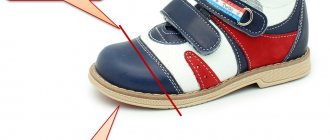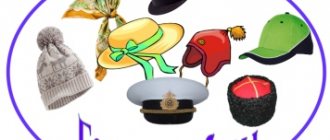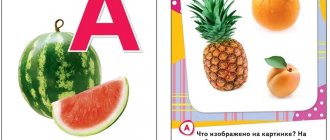Designers and clothing designers use special names for parts and cuts of clothing. Each product, be it a skirt, trousers, women's coat or dress, has a different number of cut details. It is not constant, but can change depending on the model of clothing.
Cutting details can be divided into two or three groups. For example, the parts of a women's coat pattern are divided into three main groups: parts of the top, lining and cut of the lining made of non-adhesive and adhesive materials.
This article is based on reference literature intended for tailors. In it we present the basic terms and names for designating the details of the cut of a women's demi-season coat. Many of them are also used for other women's clothing, dresses, skirts, trousers, etc.
Name of cut details
The details of the top of the coat are cut out from fabrics in the following quantities: fronts - 2 pieces, back - 3, lower half of the sleeve - 2, upper collar - 1, lower collar - 1 (from two parts), hem - 2, flap - 2, facings - 2 , facings for loops - (1-2) for each loop.
The lining parts are cut out according to the shape of the top parts; they have similar names. Shelves - 2 pcs., back - (of two parts), upper half of the sleeve - 2, lower half of the sleeve - 2, flap lining, valance for side pockets - 2, half holder - 1, hanger - 1, burlap inner pocket.
The gasket parts are cut out from cushioning fabrics (linen, cotton) or from non-woven materials, etc. They have the following names: side pad - 2 pcs., shoulder pad - 2, collar pad - 1 (of two parts). From cotton fabrics, burlap for side pockets is also cut out - 2 pieces, burlap for side pockets - 2 and linings in the low sleeves - 2.
In the upper and lower schematic drawing, the cut details are indicated by the following letters: a - front; b - back; c - upper half of the sleeve; d - lower half of the sleeve; e - upper collar; g - lower collar; h - valve; and - pocket facing; k - loop facings.
Small children
As the baby's physical activity increases, the wear resistance of his clothes should also increase.
It is difficult for a baby to move his arms and legs if he is wearing clothes that are too tight or, conversely, loose, in which the child can become entangled. It is best to choose fabrics made from natural materials, 100% cotton or with the addition of polyester and acrylic. Natural wool can cause allergies, and cashmere, despite its softness, cannot be washed frequently, which is completely impractical.
In the winter season, a child can wear rompers or a bodysuit, tights (including for boys), trousers or a skirt, a cardigan or jumper under his clothes for walking, directly over the diapers. In summer, it is recommended to protect the baby's skin from the sun with a thin cotton cloth.
Note!
- Try not to use clothes with lace or various ties so that the child cannot get his fingers tangled in them.
- Teach your child to wear thin cotton hats from infancy. They will protect him from the sun in the summer, and later there will be no problems when the hat is really needed.
- Although girls look very cute in dresses and skirts, it is difficult for them to crawl in them, and besides, trousers will prevent skin from skinning their knees.
Name of lines and cuts of cutting details
When sewing, uniform names of cuts and lines of pattern parts are used. 1. The front of the coat has the following names of cuts and construction lines. Side cut 1-2, lapel 2-3, lapel ledge 3-4, neckline 4-5, shoulder cut 5-6, armhole cut 6-7, side cut 7-8, hem cut 8-1, side dart 9, front dart 11, side pocket cut line 12, half-skid line 13, lapel bend 14, waist 15, hips 16, loops 17, control marks 18.
The back of the coat has the following cut line names: middle back line 1-2, neck cut 2-3, shoulder cut 3-4, armhole cut 4-5, side cut 5-6, bottom cut 6-1, dart along the waist line - 7, dart from the shoulder cut - 8, waistline of the hips - 9, hips - 10, control marks - 11.
The hem of a coat has the following names: outer edge cut 1-2, lapel ledge cut, or top lapel cut 2-3, rasp cut 3-4, shoulder cut 4-5, inner cut 2-3, bottom cut 6-1, line extensions - 7.
The upper half of the coat sleeve: elbow cut 1-2, roll line 2-3, front cut 3-4, bottom cut 4-1, front roll line - 5, elbow roll line - 6, control marks - 7.
The lower half of the sleeve: elbow cut 1-2, hem cut 2-3, front cut 3-4, bottom cut 4-1, control marks -7.
Upper collar: middle line - 1, departure cut - 2, end cut - 3, opening -4, posts -5, stand inflection line - 6.
The lower collar has the following names of cut details: middle cut - 1, flyaway - 2, end - 3, stand - 4, stand bend line - 5, extension line - 6.
The cutting details of the gaskets and lining have the same names of cuts and construction lines as the details of the top.
Wash
The manufacturer does not just indicate the recommended washing temperature. Many fabrics are afraid of high temperatures, for example, wool shrinks after cleaning in hot water, and silk wrinkles so that it is impossible to smooth it out later. Therefore, we advise you to pay attention to clothing tags more often.
How to choose the right temperature for washing?
In the table below we will tell you what the dots and numbers inside the basin icon mean and how to properly wash an item with such a tag.
.
| Hand wash only Forget about the washing machine, only gentle, delicate hand wash. |
| Machine wash in normal mode This symbol allows washing, soaking, heating, rinsing, rubbing and mechanical action. |
| Washing is prohibited. Do not do laundry at home. The product must be dry cleaned. |
| Wash in cool water Hand or machine wash at recommended temperature 30℃. |
| Wash in warm water Hand or machine wash at recommended temperature 40℃. |
| Wash in hot water Hand or machine wash at recommended temperature 50℃. |
| Wash in hot water Hand or machine wash at recommended temperature 60℃. |
| Wash in hot water Hand or machine wash at recommended temperature 70℃. |
| Wash in very hot water Hand or machine wash at recommended temperature 95℃. |
How to choose the right washing mode?
The number of lines under the basin symbol indicate which washing mode to choose: normal or delicate.
| Hand or delicate machine wash at 30℃ . Rub gently. You can rinse. Spin at low speed. |
| Hand or very delicate machine wash at 30 ℃ Minimum mechanical stress. Quick and gentle rinsing. Hand push-ups are prohibited. Use plenty of water. |
| Hand or very delicate machine wash at 30 ℃ Minimum mechanical stress. Quick and gentle rinsing. Hand push-ups are prohibited. Use plenty of water. |
| Hand or delicate machine wash at 40℃ . Rub gently. You can rinse. Spin at low speed. |
| Hand or very delicate machine wash at 40 ℃ Minimum mechanical stress. Quick and gentle rinsing. Hand push-ups are prohibited. Use plenty of water. |
| Hand or very delicate machine wash at 40 ℃ Minimum mechanical stress. Quick and gentle rinsing. Hand push-ups are prohibited. Use plenty of water. |
| Hand or delicate machine wash at 50℃ . Rub gently. You can rinse. Spin at low speed. |
| Hand or very delicate machine wash at 50 ℃ Minimum mechanical stress. Quick and gentle rinsing. Hand push-ups are prohibited. Use plenty of water. |
| Hand or very delicate machine wash at 50 ℃ Minimum mechanical stress. Quick and gentle rinsing. Hand push-ups are prohibited. Use plenty of water. |
| Hand or delicate machine wash at 60℃ . Rub gently. You can rinse. Spin at low speed. |
| Hand or very delicate machine wash at 60 ℃ Minimum mechanical stress. Quick and gentle rinsing. Hand push-ups are prohibited. Use plenty of water. |
| Hand or very delicate machine wash at 60 ℃ Minimum mechanical stress. Quick and gentle rinsing. Hand push-ups are prohibited. Use plenty of water. |
| Hand or delicate machine wash at 70℃ . Rub gently. You can rinse. Spin at low speed. |
| Hand or very delicate machine wash at 70 ℃ Minimum mechanical stress. Quick and gentle rinsing. Hand push-ups are prohibited. Use plenty of water. |
| Hand or very delicate machine wash at 70 ℃ Minimum mechanical stress. Quick and gentle rinsing. Hand push-ups are prohibited. Use plenty of water. |
| Hand or delicate machine wash at 95℃ Rub gently. You can rinse. Spin at low speed. |
| Hand or very delicate machine wash at 95 ℃ Minimum mechanical stress. Quick and gentle rinsing. Hand push-ups are prohibited. Use plenty of water. |
| Hand or very delicate machine wash at 95 ℃ Minimum mechanical stress. Quick and gentle rinsing. Hand push-ups are prohibited. Use plenty of water. |
Terms of cut details and structural elements
1. Bodice - the upper part of women's shoulder clothing. 2. Shelf - half of the front part of the bodice. 3. Neck - a cutout for the neck on the pattern of the front and back. 4. Rostock (obsolete) - back neck. 5. Armhole - a cutout for the arm on the front and back patterns. See also: Constructing a one-piece sleeve pattern. 6. Roll - the upper rounded part of the sleeve. 7. Dart - a stitched section of fabric in a product, which serves to create a three-dimensional shape of the product. 8. Sections - contours of cut parts. 9. Collar - a detail of a product made from the main fabric, intended for processing the border and cut according to its shape. 10. Half-skid line - the line of the center front in products with a fastener. 11. Lapel - the folded upper part of the side. 12. Ledge point - the point at which the collar begins to be sewn into the neckline. 13. Lapel ledge - the section of the side from the point of the ledge (the beginning of the collar) to the edge of the side. 14. Take-off - the processed edge of a part: collar, cuff, flounce, etc. 15. Belt belt - a part in the form of a narrow strip, used to support a belt, shoulder straps, shoulder straps, and straps. See also Processing Belt Loops. 16. Patas - decorative details on sleeves and pockets in the form of stripes of different shapes. They are made with overhead fasteners or sewn into the seams. 17. Shoulder straps - decorative details in the form of stripes, located on the shoulder or upper part of the sleeve. 18. A strap is a decorative detail used instead of a belt on the back of the product to give it a more flattering dress shape. 19. The valve is a decorative detail that forms the upper part of the pocket cut. See also Welt pocket with flap, Processing patch pockets. 20. Leaflet is a detail that forms the lower part of the pocket cut and covers the entrance to the pocket. 21. Sharevik - a strip of interlining material cut along the share thread, attached to the wrong side of the product at the site of the cut (entrance to the pocket, undercut) to protect the cuts from stretching. 22. Burlap or pocket lining is a piece necessary to design the depth of the pocket. 23. A valance is a part of the main fabric visible in the cut that covers the lining of a pocket or fastener. Turning is a part for processing a cutout or cut, cut to the shape of the area being processed. 24. Slit - a cut in the lower part of the product (sleeve), processed with a fabric allowance. See also Processing skirt vents. 25. Raskep - the seam line for sewing a collar with a hem from the shoulder seam to the ledge point. 26. Drawstring - a strip of fabric. adjustable on the product for pulling in a belt, cord or elastic band. 27. Yoke - the upper, cut-off part of the product parts (front, back, skirt, trousers). 28. Gusset - a stitched or one-piece piece with sleeves at the bottom of the armhole, providing ease of movement. 29. Edge - a section of a product part, from the fold line to the line in the facing seam. 30. Bow line - the middle line of the trousers in the front.
Preschoolers
This phase of the child’s development logically follows from the previous one, but now the child needs to learn greater independence in preparation for school: he must be able to dress, put on his shoes and go to the toilet independently. Clothes should also be chosen keeping this trend in mind.
Note!
- Despite the fact that a winter jacket with fur looks quite cute, it would be much more practical to opt for a regular jacket with a hood, which you can wash at any time.
- Waterproof boots are ideal for preschoolers - their feet will be dry and warm in any situation.
- At this age, it is still difficult for a child to tie shoelaces, so it is better to choose shoes with Velcro fastener.
Ironing
Surprisingly, not all materials can be ironed. And some things don't like high steam temperatures. These badges on clothes
will help you figure out how best to stroke her:
How to iron things correctly?
| Can be ironed Ironing allowed. |
| Do not iron Ironing is prohibited. |
| Can be ironed at low temperature Ironing allowed at temperatures up to 110℃. |
| Can be ironed at medium temperature Ironing allowed at temperatures up to 150℃. |
| Can be ironed at high temperature Ironing is allowed at temperatures up to 200℃. |
| Do not steam Smoothing with steam is prohibited. |
Whitening
Sometimes bleaches are used in the washing process. At this stage you need to be extremely careful. Some of them may leave a white spot or, in the worst case, a hole. So take a close look at your label.
and check if washing with bleach is allowed.
How to use bleach correctly?
| Bleaching is allowed. You can clean the product with chlorine and oxygen bleaches. |
| Bleaching is prohibited. Do not clean the product with chlorine or oxygen bleaches. |
| Chlorine bleaching is prohibited. You can only bleach with oxygen bleaches. |
| Chlorine bleaching is allowed. You can clean the product with chlorine-containing bleaches. |






